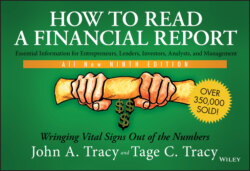Читать книгу How to Read a Financial Report - John A. Tracy - Страница 15
3 REPORTING CASH FLOWS Statement of Cash Flows
ОглавлениеChapter 2 introduces the two hardcore financial statements that are included in the financial report of a business, the income statement (Exhibit 2.1) and the balance sheet (Exhibit 2.2). Both of these provide a comprehensive summary of the financial performance and financial condition of the business; however, this is not the end of the story. Financial reporting standards require that a statement of cash flows also be presented for the same time period as the income statement.
This third financial statement, as its title implies, focuses on the cash flows of the period. The cash flow statement is not more important than the income statement and balance sheet. Rather, it discloses additional information that supplements the income statement and balance sheet.
Exhibit 3.1 presents the statement of cash flows for our business example. This financial statement has three parts, or layers: 1) cash flows from operating activities, 2) cash flows from investing activities, and 3) cash flows from financing activities. Operating activities relate to the profit-making activities of the business. Of course, a business may suffer a loss instead of making profit. On a statement of cash flows, the term “operating activities” refers to revenue and expenses (as well as gains and losses) during the period that culminate in the bottom-line net income or loss for the period.
EXHIBIT 3.1 STATEMENT OF CASH FLOWS FOR YEAR
| Dollar Amounts in Thousands | ||
| Cash Flow from Operating Activities | ||
| Net Income (from Income Statement) | $ 2,642) | |
| Accounts Receivable Increase) | (320) | |
| Inventory Increase) | (935) | |
| Prepaid Expenses Increase) | (275) | |
| Depreciation Expense) | 785) | |
| Accounts Payable Increase) | 645) | |
| Accrued Expenses Payable Increase) | 480) | |
| Income Tax Payable Increase) | 83) | $ 3,105) |
| Cash Flow from Investing Activities) | ||
| Expenditures for Property, Plant, and Equipment) | $ (3,050) | |
| Expenditures for Intangible Assets) | (575) | (3,625) |
| Cash Flow from Financing Activities) | ||
| Increase in Short-Term Debt) | $ 125) | |
| Increase in Long-Term Debt) | 500) | |
| Issuance of Additional Capital Stock Shares) | 175) | |
| Distribution of Cash Dividends from Profit) | (750) | 50) |
| Decrease in Cash During Year) | $0(470) | |
| Cash Balance at Start of Year) | 3,735) | |
| Cash Balance at End of Year) | $ 3,265) |
The income statement of our business example (Exhibit 2.1) divulges 10 lines of information and its balance sheet has 21 lines. So, already you have 31 items of information, which take time to read. The statement of cash flows adds another 20 lines of information to read. Is this financial statement worth the additional time it takes to read it? What’s the payoff?
For many financial report readers, the main value of the statement of cash flows is that it discloses the cash flow from operating activities. They zero in on this number, and may not read any other line of information in the financial statement. This key metric is commonly called cash flow from profit. In its income statement for the year (Exhibit 2.1), the company reports that it earned $2,642,000 net income, or bottom-line profit. In its statement of cash flows for the year (Exhibit 3.1) the company reports that it generated $3,105,000 cash flow from operating activities, that is, from profit-making activities. In short, profit is $2,642,000 in one financial statement and $3,105,000 in another statement. This can be confusing, to say the least.
How can cash flow from profit be higher than profit? Is one of the two numbers fake profit? Where did the extra cash come from? In other situations, could cash flow be less than profit? (Yes, it can be.) A short explanation for this discrepancy is that actual cash inflow from revenue is typically somewhat higher or lower than the amount of revenue recorded for the period. And, actual cash outflows for expenses typically differ from the amounts of expenses recorded for the period.
